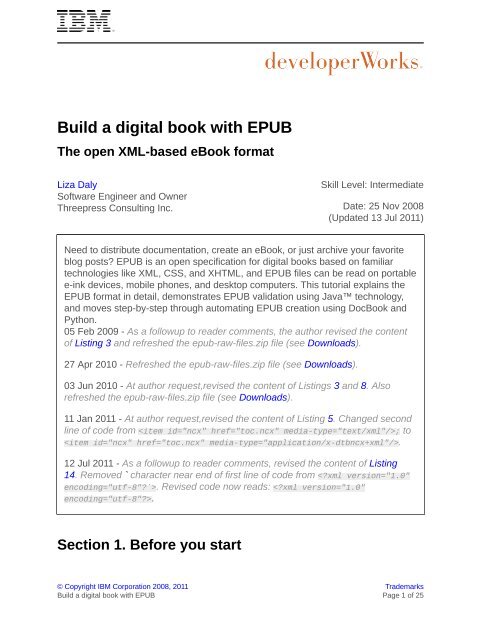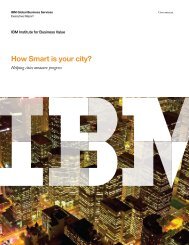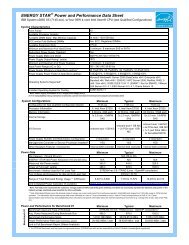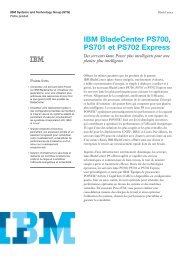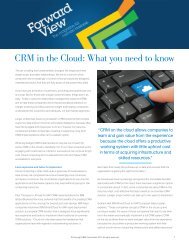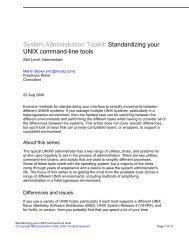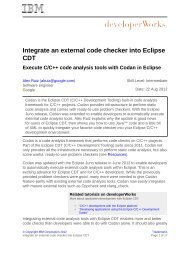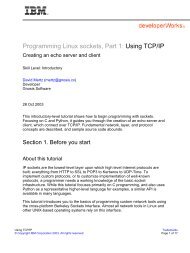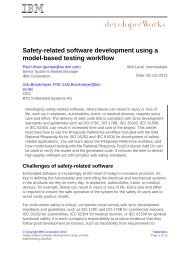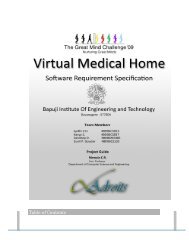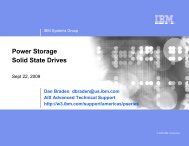Build a digital book with EPUB The open - IBM
Build a digital book with EPUB The open - IBM
Build a digital book with EPUB The open - IBM
Create successful ePaper yourself
Turn your PDF publications into a flip-book with our unique Google optimized e-Paper software.
<strong>Build</strong> a <strong>digital</strong> <strong>book</strong> <strong>with</strong> <strong>EPUB</strong><br />
<strong>The</strong> <strong>open</strong> XML-based eBook format<br />
Liza Daly<br />
Software Engineer and Owner<br />
Threepress Consulting Inc.<br />
Skill Level: Intermediate<br />
Date: 25 Nov 2008<br />
(Updated 13 Jul 2011)<br />
Need to distribute documentation, create an eBook, or just archive your favorite<br />
blog posts? <strong>EPUB</strong> is an <strong>open</strong> specification for <strong>digital</strong> <strong>book</strong>s based on familiar<br />
technologies like XML, CSS, and XHTML, and <strong>EPUB</strong> files can be read on portable<br />
e-ink devices, mobile phones, and desktop computers. This tutorial explains the<br />
<strong>EPUB</strong> format in detail, demonstrates <strong>EPUB</strong> validation using Java technology,<br />
and moves step-by-step through automating <strong>EPUB</strong> creation using DocBook and<br />
Python.<br />
05 Feb 2009 - As a followup to reader comments, the author revised the content<br />
of Listing 3 and refreshed the epub-raw-files.zip file (see Downloads).<br />
27 Apr 2010 - Refreshed the epub-raw-files.zip file (see Downloads).<br />
03 Jun 2010 - At author request,revised the content of Listings 3 and 8. Also<br />
refreshed the epub-raw-files.zip file (see Downloads).<br />
11 Jan 2011 - At author request,revised the content of Listing 5. Changed second<br />
line of code from ; to<br />
.<br />
12 Jul 2011 - As a followup to reader comments, revised the content of Listing<br />
14. Removed ` character near end of first line of code from . Revised code now reads: .<br />
Section 1. Before you start<br />
© Copyright <strong>IBM</strong> Corporation 2008, 2011 Trademarks<br />
<strong>Build</strong> a <strong>digital</strong> <strong>book</strong> <strong>with</strong> <strong>EPUB</strong> Page 1 of 25
developerWorks® ibm.com/developerWorks/<br />
This tutorial guides you through creating eBooks in the <strong>EPUB</strong> format. <strong>EPUB</strong> is an<br />
XML-based, developer-friendly format that is emerging as the de facto standard for<br />
<strong>digital</strong> <strong>book</strong>s. But <strong>EPUB</strong> isn't just for <strong>book</strong>s: With it, you can:<br />
• Bundle documentation for offline reading or easy distribution<br />
• Package blog posts or other Web-native content<br />
• <strong>Build</strong>, search, and remix using common <strong>open</strong> source tools<br />
About this tutorial<br />
Frequently used acronyms<br />
• API: application programming interface<br />
• CSS: Cascading stylesheets<br />
• DOM: Document Object Model<br />
• DTD: Document type definition<br />
• GUI: Graphical user interface<br />
• HTML: Hypertext Markup Language<br />
• SAX: Simple API For XML<br />
• W3C: World Wide Web Consortium<br />
• XHTML: Extensible HTML<br />
• XML: Extensible Markup Language<br />
You start this tutorial by generating an <strong>EPUB</strong> <strong>book</strong> manually to help you learn all the<br />
components and required files. Next, the tutorial shows how to bundle the finished<br />
<strong>digital</strong> <strong>book</strong> and validate it against the specification as well as how to test it in various<br />
reading systems.<br />
<strong>The</strong>n, it covers generating <strong>EPUB</strong> from DocBook XML—one of the most widely<br />
used standards for technical documentation—and how to use Python to completely<br />
automate <strong>EPUB</strong> creation <strong>with</strong> DocBook from end to end.<br />
Objectives<br />
In this tutorial, you:<br />
• Learn what <strong>EPUB</strong> is, who's behind it, and who's adopting it<br />
• Explore the structure of an <strong>EPUB</strong> bundle, including its required files and their<br />
schemas<br />
• Create a valid <strong>EPUB</strong> file from scratch using simple content<br />
• Use <strong>open</strong> source tools to produce <strong>EPUB</strong> files from DocBook, a widely used<br />
schema for technical documentation and <strong>book</strong>s<br />
• Automate <strong>EPUB</strong> conversion using Python and DocBook<br />
Prerequisites<br />
No particular operating system is assumed for this tutorial, although you should be<br />
familiar <strong>with</strong> the mechanics of creating files and directories. Use of an XML editor or<br />
integrated development environment (IDE) is strongly recommended.<br />
<strong>Build</strong> a <strong>digital</strong> <strong>book</strong> <strong>with</strong> <strong>EPUB</strong> Page 2 of 25
ibm.com/developerWorks/ developerWorks®<br />
For the later parts of the tutorial on automating <strong>EPUB</strong> creation, this tutorial assumes<br />
that you know one or more basic XML processing skills—XSLT, DOM, or SAX-based<br />
parsing—and how to construct an XML document using an XML-native API.<br />
No familiarity <strong>with</strong> the <strong>EPUB</strong> file format is necessary to complete this tutorial.<br />
System requirements<br />
To complete the examples in this tutorial, you need a Java interpreter (version 1.5<br />
or later) and a Python interpreter (version 2.4 or later) as well as the required XML<br />
libraries for each. However, experienced XML developers should be able to adapt the<br />
examples to any programming language <strong>with</strong> XML libraries.<br />
Section 2. About the <strong>EPUB</strong> format<br />
Learn the background of <strong>EPUB</strong>, what <strong>EPUB</strong> is most commonly used for, and how<br />
<strong>EPUB</strong> differs from the Portable Document Format (PDF).<br />
What is <strong>EPUB</strong>?<br />
<strong>EPUB</strong> is the XML format for reflowable <strong>digital</strong> <strong>book</strong>s and publications standardized by<br />
the International Digital Publishing Forum (IDPF), a trade and standards association<br />
for the <strong>digital</strong> publishing industry. IDPF officially adopted <strong>EPUB</strong> in October 2007<br />
and by 2008 had seen rapid adoption by major publishers. You can read the <strong>EPUB</strong><br />
format using a variety of <strong>open</strong> source and commercial software on all major operating<br />
systems, e-ink devices such as the Sony PRS, and small devices such as the Apple<br />
iPhone.<br />
Who is producing <strong>EPUB</strong>? Is it only for <strong>book</strong>s?<br />
Although traditional print publishers were the first to adopt <strong>EPUB</strong>, nothing in the<br />
format limits its use to eBooks. With freely available software tools, you can bundle<br />
Web pages as <strong>EPUB</strong>, convert plain text files, or transform existing DocBook XML<br />
documentation into well-formed and valid <strong>EPUB</strong>. (I cover the latter in From DocBook<br />
to <strong>EPUB</strong>.)<br />
How is <strong>EPUB</strong> different from PDF?<br />
PDF is still the most widely used electronic document format in the world. From a<br />
<strong>book</strong> publisher's point of view, PDF has several advantages:<br />
• PDF files allow pixel-perfect control over layout, including complex print-friendly<br />
layouts such as multiple columns and alternate recto/verso styles.<br />
• PDFs can be generated by a wide variety of GUI-based document tools, such<br />
as Microsoft® Office Word or Adobe® InDesign®.<br />
• PDF readers are ubiquitous and installed on most modern computers.<br />
<strong>Build</strong> a <strong>digital</strong> <strong>book</strong> <strong>with</strong> <strong>EPUB</strong> Page 3 of 25
developerWorks® ibm.com/developerWorks/<br />
• Specific fonts can be embedded in PDF to control the final output exactly.<br />
Three standards in one<br />
<strong>EPUB</strong> consists of three separate IDPF specifications, although in practice,<br />
it's safe to refer to them collectively as EPeUB:<br />
• Open eBook Publication Structure Container Format (OCF):<br />
Specifies the directory tree structure and file format (ZIP) of an<br />
<strong>EPUB</strong> archive.<br />
• Open Publication Structure (OPS): Defines the common<br />
vocabularies for the eBook, especially the formats allowed to be<br />
used for <strong>book</strong> content (for example, XHTML and CSS).<br />
• Open Packaging Format (OPF): Describes the required and<br />
optional metadata, reading order, and table of contents in an <strong>EPUB</strong>.<br />
Additionally, <strong>EPUB</strong> reuses several other standards, such as XHTML<br />
version 1.0 and Digital Accessible Information SYstem (DAISY), for specific<br />
types of content <strong>with</strong>in the <strong>EPUB</strong> archive.<br />
From a software developer's point of view, PDF falls far short of the ideal:<br />
• It's not a trivial standard to learn; therefore, it's not a simple matter to throw<br />
together your own PDF-generating code.<br />
• Although PDF is now an International Organization for Standardization (ISO)<br />
standard (ISO 32000-1:2008), traditionally it has been controlled by a single<br />
corporation: Adobe Systems.<br />
• Although PDF libraries are available for most programming languages, many<br />
are commercial or are embedded in GUI applications and not easily controlled<br />
by external processes. Not all free libraries continue to be actively maintained.<br />
• PDF-native text can be extracted and searched programmatically, but few PDFs<br />
are tagged such that conversion to a Web-friendly format is simple or reliable.<br />
• PDF documents aren't easily reflowable, meaning that they don't adapt well to<br />
small screens or to radical changes to their layouts.<br />
Why <strong>EPUB</strong> is friendly to developers<br />
<strong>EPUB</strong> addresses all the flaws in PDF as they relate to developer friendliness. An<br />
<strong>EPUB</strong> is a simple ZIP-format file (<strong>with</strong> an .epub extension) that contains files ordered<br />
in a proscribed manner. <strong>The</strong>re are a few tricky requirements about how the ZIP<br />
archive is prepared, which will be discussed in detail later in Bundling your <strong>EPUB</strong> file<br />
as a ZIP archive. Otherwise, <strong>EPUB</strong> is simple:<br />
• Nearly everything in <strong>EPUB</strong> is XML. <strong>EPUB</strong> files can be built using standard XML<br />
toolkits <strong>with</strong>out any special or proprietary software.<br />
• <strong>EPUB</strong> content (the actual text of an eBook) is almost always XHTML version<br />
1.1. (An alternative format is DTBook, a standard for encoding <strong>book</strong>s for the<br />
visually impaired. See Resources for more information on DTBook, which is not<br />
covered in this tutorial).<br />
• Most of the <strong>EPUB</strong> XML schemas are taken from existing, published<br />
specifications that are freely available.<br />
<strong>Build</strong> a <strong>digital</strong> <strong>book</strong> <strong>with</strong> <strong>EPUB</strong> Page 4 of 25
ibm.com/developerWorks/ developerWorks®<br />
<strong>The</strong> two key points are that <strong>EPUB</strong> metadata is XML and <strong>EPUB</strong> content is XHTML.<br />
If your documentation-building system produces output for the Web and/or is based<br />
on XML, then it is very close to being able to produce <strong>EPUB</strong>, as well.<br />
Section 3. <strong>Build</strong>ing your first <strong>EPUB</strong><br />
A minimally conforming <strong>EPUB</strong> bundle has several required files. <strong>The</strong> specification<br />
can be quite strict about the format, contents, and location of those files <strong>with</strong>in the<br />
<strong>EPUB</strong> archive. This section explains what you must know when you work <strong>with</strong> the<br />
<strong>EPUB</strong> standard.<br />
Anatomy of an <strong>EPUB</strong> bundle<br />
<strong>The</strong> basic structure of a minimal <strong>EPUB</strong> file follows the pattern in Listing 1. When<br />
ready for distribution, this directory structure is bundled together into a ZIP-format<br />
file, <strong>with</strong> a few special requirements discussed in Bundling your <strong>EPUB</strong> file as a ZIP<br />
archive.<br />
Listing 1. Directory and file layout for a simple <strong>EPUB</strong> archive<br />
mimetype<br />
META-INF/<br />
container.xml<br />
OEBPS/<br />
content.opf<br />
title.html<br />
content.html<br />
stylesheet.css<br />
toc.ncx<br />
images/<br />
cover.png<br />
Note: A sample <strong>book</strong> following this pattern is available from Downloads, but I<br />
recommend that you create your own as you follow the tutorial.<br />
To start building your <strong>EPUB</strong> <strong>book</strong>, create a directory for the <strong>EPUB</strong> project. Open a<br />
text editor or an IDE such as Eclipse. I recommend using an editor that has an XML<br />
mode—in particular, one that can validate against the Relax NG schemas listed in<br />
Resources.<br />
<strong>The</strong> mimetype file<br />
This one's pretty easy: <strong>The</strong> mimetype file is required and must be named mimetype.<br />
<strong>The</strong> contents of the file are always:<br />
application/epub+zip<br />
Note that the mimetype file cannot contain any newlines or carriage returns.<br />
<strong>Build</strong> a <strong>digital</strong> <strong>book</strong> <strong>with</strong> <strong>EPUB</strong> Page 5 of 25
developerWorks® ibm.com/developerWorks/<br />
Additionally, the mimetype file must be the first file in the ZIP archive and must not<br />
itself be compressed. You'll see how to include it using common ZIP arguments in<br />
Bundling your <strong>EPUB</strong> file as a ZIP archive. For now, just create this file and save it,<br />
making sure that it's at the root level of your <strong>EPUB</strong> project.<br />
META-INF/container.xml<br />
At the root level of the <strong>EPUB</strong>, there must be a META-INF directory, and it must<br />
contain a file named container.xml. <strong>EPUB</strong> reading systems will look for this file first,<br />
as it points to the location of the metadata for the <strong>digital</strong> <strong>book</strong>.<br />
Create a directory called META-INF. Inside it, <strong>open</strong> a new file called container.xml<br />
for writing. <strong>The</strong> container file is very small, but its structural requirements are strict.<br />
Paste the code in Listing 2 into META-INF/container.xml.<br />
Listing 2. Sample container.xml file<br />
<br />
<br />
<br />
<br />
<br />
<br />
<strong>The</strong> value of full-path (in bold) is the only part of this file that will ever vary. <strong>The</strong><br />
directory path must be relative to the root of the <strong>EPUB</strong> file itself, not relative to the<br />
META-INF directory.<br />
More about META-INF<br />
<strong>The</strong> META-INF directory can contain a few optional files, as well. <strong>The</strong>se<br />
files allow <strong>EPUB</strong> to support <strong>digital</strong> signatures, encryption, and <strong>digital</strong> rights<br />
management (DRM). <strong>The</strong>se topics are not covered in this tutorial. See the<br />
OCF specification for more information.<br />
<strong>The</strong> mimetype and container files are the only two whose location in the <strong>EPUB</strong><br />
archive are strictly controlled. As recommended (although not required), store the<br />
remaining files in the <strong>EPUB</strong> in a sub-directory. (By convention, this is usually called<br />
OEBPS, for Open eBook Publication Structure, but can be whatever you like.)<br />
Next, create the directory named OEBPS in your <strong>EPUB</strong> project. <strong>The</strong> following section<br />
of this tutorial covers the files that go into OEBPS—the real meat of the <strong>digital</strong> <strong>book</strong>:<br />
its metadata and its pages.<br />
Open Packaging Format metadata file<br />
Although this file can be named anything, the OPF file is conventionally called<br />
content.opf. It specifies the location of all the content of the <strong>book</strong>, from its text to<br />
other media such as images. It also points to another metadata file, the Navigation<br />
Center eXtended (NCX) table of contents.<br />
<strong>Build</strong> a <strong>digital</strong> <strong>book</strong> <strong>with</strong> <strong>EPUB</strong> Page 6 of 25
ibm.com/developerWorks/ developerWorks®<br />
<strong>The</strong> OPF file is the most complex metadata in the <strong>EPUB</strong> specification. Create<br />
OEBPS/content.opf, and paste the contents of Listing 3 into it.<br />
Listing 3. OPF content file <strong>with</strong> sample metadata<br />
<br />
<br />
<br />
Hello World: My First <strong>EPUB</strong><br />
My Name<br />
urn:uuid:0cc33cbd-94e2-49c1-909a-72ae16bc2658<br />
en-US<br />
<br />
<br />
<br />
<br />
<br />
<br />
<br />
<br />
<br />
<br />
<br />
<br />
<br />
<br />
<br />
<br />
<br />
OPF schemas and namespaces<br />
<strong>The</strong> OPF document itself must use the namespace http://www.idpf.org/2007/opf, and<br />
the metadata will be in the Dublin Core Metadata Initiative (DCMI) namespace, http://<br />
purl.org/dc/elements/1.1/.<br />
This would be a good time to add the OPF and DCMI schema to your XML editor. All<br />
the schemas used in <strong>EPUB</strong> are available from Downloads.<br />
Metadata<br />
Dublin Core defines a set of common metadata terms that you can use to describe<br />
a wide variety of <strong>digital</strong> materials; it's not part of the <strong>EPUB</strong> specification itself. Any of<br />
these terms are allowed in the OPF metadata section. When you build an <strong>EPUB</strong> for<br />
distribution, include as much detail as you can here, although the extract provided in<br />
Listing 4 is sufficient to start.<br />
Listing 4. Extract of OPF metadata<br />
...<br />
<br />
Hello World: My First <strong>EPUB</strong><br />
My Name<br />
urn:uuid:12345<br />
<br />
<br />
...<br />
<strong>Build</strong> a <strong>digital</strong> <strong>book</strong> <strong>with</strong> <strong>EPUB</strong> Page 7 of 25
developerWorks® ibm.com/developerWorks/<br />
<strong>The</strong> two required terms are title and identifier. According to the <strong>EPUB</strong> specification,<br />
the identifier must be a unique value, although it's up to the <strong>digital</strong> <strong>book</strong> creator to<br />
define that unique value. For <strong>book</strong> publishers, this field will typically contain an ISBN<br />
or Library of Congress number. For other <strong>EPUB</strong> creators, consider using a URL or a<br />
large, randomly generated unique user ID (UUID). Note that the value of the attribute<br />
unique-identifier must match the ID attribute of the dc:identifier element.<br />
Other metadata to consider adding, if it's relevant to your content, include:<br />
• Language (as dc:language).<br />
• Publication date (as dc:date).<br />
• Publisher (as dc:publisher). (This can be your company or individual name.)<br />
• Copyright information (as dc:rights). (If releasing the work under a Creative<br />
Commons license, put the URL for the license here.)<br />
See Resources for more information on DCMI.<br />
Including a meta element <strong>with</strong> the name attribute containing cover is not part of the<br />
<strong>EPUB</strong> specification directly, but is a recommended way to make cover pages and<br />
images more portable. Some <strong>EPUB</strong> renderers prefer to use an image file as the<br />
cover, while others will use an XHTML file containing an inlined cover image. This<br />
example shows both forms. <strong>The</strong> value of the meta element's content attribute should<br />
be the ID of the <strong>book</strong>'s cover image in the manifest, which is the next part of the OPF<br />
file.<br />
Manifest<br />
<strong>The</strong> OPF manifest lists all the resources found in the <strong>EPUB</strong> that are part of the<br />
content (and excluding metadata). This usually means a list of XHTML files that make<br />
up the text of the eBook plus some number of related media such as images. <strong>EPUB</strong><br />
encourages the use of CSS for styling <strong>book</strong> content, so CSS files are also included<br />
in the manifest. Every file that goes into your <strong>digital</strong> <strong>book</strong> must be listed in the<br />
manifest.<br />
Listing 5 shows the extracted manifest section.<br />
Listing 5. Extract of OPF manifest<br />
...<br />
<br />
<br />
<br />
<br />
<br />
<br />
<br />
...<br />
<strong>Build</strong> a <strong>digital</strong> <strong>book</strong> <strong>with</strong> <strong>EPUB</strong> Page 8 of 25
ibm.com/developerWorks/ developerWorks®<br />
Advanced OPF manifests<br />
A more advanced sample of a manifest file will include multiple XHTML<br />
files as well as images and a CSS. Get a complete <strong>EPUB</strong> <strong>with</strong> examples of<br />
common types from Downloads.<br />
You must include the first item, toc.ncx (discussed in the next section). Note that all<br />
items have an appropriate media-type value and that the media type for the XHTML<br />
content is application/xhtml+xml. This exact value is required and cannot be text/<br />
html or some other type.<br />
<strong>EPUB</strong> supports four image file formats as core types: Joint Photographic Experts<br />
Group (JPEG), Portable Network Graphics (PNG), Graphics Interchange Format<br />
(GIF), and Scalable Vector Graphics (SVG). You can include non-supported file<br />
types if you provide a fall-back to a core type. See the OPF specification for more<br />
information on fall-back items.<br />
<strong>The</strong> values of the href attribute should be a Uniform Resource Identifier (URI) that is<br />
relative to the OPF file. (This is easy to confuse <strong>with</strong> the reference to the OPF file in<br />
the container.xml file, where it must be relative to the <strong>EPUB</strong> as a whole.) In this case,<br />
the OPF file is in the same OEBPS directory as your content, so no path information<br />
is required here.<br />
Spine<br />
Although the manifest tells the <strong>EPUB</strong> reader which files are part of the archive,<br />
the spine indicates the order in which they appear, or—in <strong>EPUB</strong> terms—the linear<br />
reading order of the <strong>digital</strong> <strong>book</strong>. One way to think of the OPF spine is that it defines<br />
the order of the "pages" of the <strong>book</strong>. <strong>The</strong> spine is read in document order, from top to<br />
bottom. Listing 6 shows an extract from the OPF file.<br />
Listing 6. Extract of OPF spine<br />
...<br />
<br />
<br />
<br />
<br />
...<br />
Each itemref element has a required attribute idref, which must match one of<br />
the IDs in the manifest. <strong>The</strong> toc attribute is also required. It references an ID in the<br />
manifest that must indicate the file name of the NCX table of contents.<br />
<strong>The</strong> linear attribute in the spine indicates whether the item is considered part of the<br />
linear reading order versus being extraneous front- or end-matter. I recommend that<br />
you define any cover page as linear=no. Conforming <strong>EPUB</strong> reading systems will<br />
<strong>open</strong> the <strong>book</strong> to the first item in the spine that's not set as linear=no.<br />
<strong>Build</strong> a <strong>digital</strong> <strong>book</strong> <strong>with</strong> <strong>EPUB</strong> Page 9 of 25
developerWorks® ibm.com/developerWorks/<br />
Guide<br />
<strong>The</strong> last part of the OPF content file is the guide. This section is optional but<br />
recommended. Listing 7 shows an extract from a guide file.<br />
Listing 7. Extract of an OPF guide<br />
...<br />
<br />
<br />
<br />
...<br />
<strong>The</strong> guide is a way of providing semantic information to an <strong>EPUB</strong> reading system.<br />
While the manifest defines the physical resources in the <strong>EPUB</strong> and the spine<br />
provides information about their order, the guide explains what the sections mean.<br />
Here's a partial list of the values that are allowed in the OPF guide:<br />
• cover: <strong>The</strong> <strong>book</strong> cover<br />
• title-page: A page <strong>with</strong> author and publisher information<br />
• toc: <strong>The</strong> table of contents<br />
For a complete list, see the OPF 2.0 specification, available from Resources.<br />
NCX table of contents<br />
Overlap between NCX and OPF metadata<br />
Because the NCX is borrowed from another standard, there is some<br />
overlap between the information encoded in the NCX and that in the OPF.<br />
This is rarely a problem when you generate <strong>EPUB</strong>s programmatically,<br />
where the same code can output to two different files. Take care to put the<br />
same information in both places, as different <strong>EPUB</strong> readers might use the<br />
values from one or the other.<br />
Although the OCF file is defined as part of <strong>EPUB</strong> itself, the last major metadata file is<br />
borrowed from a different <strong>digital</strong> <strong>book</strong> standard. DAISY is a consortium that develops<br />
data formats for readers who are unable to use traditional <strong>book</strong>s, often because of<br />
visual impairments or the inability to manipulate printed works. <strong>EPUB</strong> has borrowed<br />
DAISY's NCX DTD. <strong>The</strong> NCX defines the table of contents of the <strong>digital</strong> <strong>book</strong>. In<br />
complex <strong>book</strong>s, it is typically hierarchical, containing nested parts, chapters, and<br />
sections.<br />
Using your XML editor, create OEBPS/toc.ncx, and include the code in Listing 8.<br />
Listing 8. Simple NCX file<br />
<br />
<br />
<br />
<br />
<strong>Build</strong> a <strong>digital</strong> <strong>book</strong> <strong>with</strong> <strong>EPUB</strong> Page 10 of 25
ibm.com/developerWorks/ developerWorks®<br />
<br />
<br />
<br />
<br />
<br />
<br />
Hello World: My First <strong>EPUB</strong><br />
<br />
<br />
<br />
<br />
Book cover<br />
<br />
<br />
<br />
<br />
<br />
Contents<br />
<br />
<br />
<br />
<br />
<br />
NCX metadata<br />
<strong>The</strong> DTD requires four meta elements inside the NCX tag:<br />
• uid: Is the unique ID for the <strong>digital</strong> <strong>book</strong>. This element should match the<br />
dc:identifier in the OPF file.<br />
• depth: Reflects the level of the hierarchy in the table of contents. This example<br />
has only one level, so this value is 1.<br />
• totalPageCount and maxPageNumber: Apply only to paper <strong>book</strong>s and can be left<br />
at 0.<br />
<strong>The</strong> contents of docTitle/text is the title of the work, and matches the value of<br />
dc:title in the OPF.<br />
NCX navMap<br />
What's the difference between the NCX and the OPF<br />
spine?<br />
It's okay to be confused, as both files describe the order and contents of<br />
the document. <strong>The</strong> easiest way to explain the difference is through analogy<br />
<strong>with</strong> a printed <strong>book</strong>: <strong>The</strong> OPF spine describes how the sections of the <strong>book</strong><br />
are physically bound together, such that turning a page at the end of one<br />
chapter reveals the first page of the second chapter. <strong>The</strong> NCX describes<br />
the table of contents at the beginning of the <strong>book</strong>. <strong>The</strong> table of contents<br />
always includes all the major sections of the <strong>book</strong>, but it might also list subsections<br />
that don't occur on their own pages.<br />
A good rule of thumb is that the NCX often contains more navPoint<br />
elements than there are itemref elements in the OPF spine. In practice,<br />
all the items in the spine appear in the NCX, but the NCX can be more<br />
granular than the spine.<br />
<strong>Build</strong> a <strong>digital</strong> <strong>book</strong> <strong>with</strong> <strong>EPUB</strong> Page 11 of 25
developerWorks® ibm.com/developerWorks/<br />
<strong>The</strong> navMap is the most important part of the NCX file, as it defines the table of<br />
contents for the actual <strong>book</strong>. <strong>The</strong> navMap contains one or more navPoint elements.<br />
Each navPoint must contain the following elements:<br />
• A playOrder attribute, which reflects the reading order of the document. This<br />
follows the same order as the list of itemref elements in the OPF spine.<br />
• A navLabel/text element, which describes the title for this section of the <strong>book</strong>.<br />
This is typically a chapter title or number, such as "Chapter One," or—as in this<br />
example—"Cover page."<br />
• A content element whose src attribute points to the physical resource<br />
containing the content. This will be a file declared in the OPF manifest. (It is also<br />
acceptable to use fragment identifiers here to point to anchors <strong>with</strong>in XHTML<br />
content—for example, content.html#footnote1.)<br />
• Optionally, one or more child navPoint elements. Nested points are how<br />
hierarchical documents are expressed in the NCX.<br />
<strong>The</strong> structure of the sample <strong>book</strong> is simple: It has only two pages, and they are<br />
not nested. That means that you'll have two navPoint elements <strong>with</strong> ascending<br />
playOrder values, starting at 1. In the NCX, you have the opportunity to name these<br />
sections, allowing readers to jump into different parts of the eBook.<br />
Adding the final content<br />
Now you know all the metadata required in <strong>EPUB</strong>, so it's time to put in the actual<br />
<strong>book</strong> content. You can use the sample content provided in Downloads or create your<br />
own, as long as the file names match the metadata.<br />
Next, create these files and folder:<br />
• title.html: This file will be the title page for the <strong>book</strong>. Create this file and include<br />
an img element that references a cover image, <strong>with</strong> the value of the src attribute<br />
as images/cover.png.<br />
• images: Create this folder inside OEBPS, then copy the sample image (or<br />
create your own), naming it cover.png.<br />
• content.html: This will be the actual text of the <strong>book</strong>.<br />
• stylesheet.css: Place this file in the same OEBPS directory as the XHTML<br />
files. This file can contain any CSS declarations you like, such as setting the<br />
font-face or text color. See Listing 10 for an example of such a CSS file.<br />
XHTML and CSS in an <strong>EPUB</strong> <strong>book</strong><br />
Listing 9 contains an example of a valid <strong>EPUB</strong> content page. Use this sample for<br />
your title page (title.html) and a similar one for the main content page (content.html)<br />
of your <strong>book</strong>.<br />
<strong>Build</strong> a <strong>digital</strong> <strong>book</strong> <strong>with</strong> <strong>EPUB</strong> Page 12 of 25
ibm.com/developerWorks/ developerWorks®<br />
Listing 9. Sample title page (title.html)<br />
<br />
<br />
Hello World: My First <strong>EPUB</strong><br />
<br />
<br />
<br />
Hello World: My First <strong>EPUB</strong><br />
<br />
<br />
<br />
XHTML content in <strong>EPUB</strong> follows a few rules that might be unfamiliar to you from<br />
general Web development:<br />
• <strong>The</strong> content must validate as XHTML 1.1: <strong>The</strong> only significant difference<br />
between XHTML 1.0 Strict and XHTML 1.1 is that the name attribute has been<br />
removed. (Use IDs to refer to anchors <strong>with</strong>in content.)<br />
• img elements can only reference images that are local to the eBook: <strong>The</strong><br />
elements cannot reference images on the Web.<br />
• script blocks should be avoided: <strong>The</strong>re is no requirement for <strong>EPUB</strong> readers<br />
to support JavaScript code.<br />
<strong>The</strong>re are some minor differences in the way <strong>EPUB</strong> supports CSS, but none that<br />
affect common uses of styles (consult the OPS specification for details). Listing 10<br />
demonstrates a simple CSS file that you can apply to the content to set basic font<br />
guidelines and to color headings in red.<br />
Listing 10. Sample styles for the eBook (stylesheet.css)<br />
body {<br />
font-family: sans-serif;<br />
}<br />
h1,h2,h3,h4 {<br />
font-family: serif;<br />
color: red;<br />
}<br />
One point of interest is that <strong>EPUB</strong> specifically supports the CSS 2 @font-face rule,<br />
which allows for embedded fonts. If you create technical documentation, this is<br />
probably not relevant, but developers who build <strong>EPUB</strong>s in multiple languages or for<br />
specialized domains will appreciate the ability to specify exact font data.<br />
You now have everything you need to create your first <strong>EPUB</strong> <strong>book</strong>. In the next<br />
section, you'll bundle the <strong>book</strong> according to the OCF specifications and find out how<br />
to validate it.<br />
Section 4. Package and check your <strong>EPUB</strong><br />
<strong>Build</strong> a <strong>digital</strong> <strong>book</strong> <strong>with</strong> <strong>EPUB</strong> Page 13 of 25
developerWorks® ibm.com/developerWorks/<br />
By this point, you should have an <strong>EPUB</strong> bundle ready to package. This bundle will<br />
either be a new <strong>book</strong> that you created yourself or one that uses the raw files available<br />
from Downloads.<br />
Bundling your <strong>EPUB</strong> file as a ZIP archive<br />
<strong>The</strong> OEBPS Container Format portion of the <strong>EPUB</strong> specification has several things<br />
to say about <strong>EPUB</strong> and ZIP, but the most important are:<br />
• <strong>The</strong> first file in the archive must be the mimetype file (see Mimetype in this<br />
tutorial). <strong>The</strong> mimetype file must not be compressed. This allows non-ZIP<br />
utilities to uncover the mimetype by reading the raw bytes starting from position<br />
30 in the <strong>EPUB</strong> bundle.<br />
• <strong>The</strong> ZIP archive cannot be encrypted. <strong>EPUB</strong> supports encryption but not at the<br />
level of the ZIP file.<br />
Using ZIP version 2.3 under a UNIX®-like operating system, create the <strong>EPUB</strong> ZIP<br />
file in two commands, as in Listing 11. (<strong>The</strong>se commands assume that your current<br />
working directory is your <strong>EPUB</strong> project.)<br />
Listing 11. Bundling the <strong>EPUB</strong> into a valid epub+zip file<br />
$ zip -0Xq my-<strong>book</strong>.epub mimetype<br />
$ zip -Xr9Dq my-<strong>book</strong>.epub *<br />
In the first command, you create the new ZIP archive and add the mimetype file<br />
<strong>with</strong> no compression. In the second, you add the remaining items. <strong>The</strong> flags -X and<br />
-D minimize extraneous information in the .zip file; -r will recursively include the<br />
contents of META-INF and OEBPS directories.<br />
<strong>EPUB</strong> validation<br />
Although the <strong>EPUB</strong> standard isn't especially difficult, its XML files must be validated<br />
against specific schemas. If you use a schema-aware XML editor to generate<br />
the metadata and XHTML, you're over halfway there. Make a final check <strong>with</strong> the<br />
EpubCheck package (see Resources).<br />
Adobe maintains the EpubCheck package, and it's available as <strong>open</strong> source under<br />
the Berkeley Software Distribution (BSD) license. It is a Java program that can be<br />
run as a stand-alone tool or as a Web application, or you can integrate it into an<br />
application running under the Java Runtime Environment (JRE) version 1.5 or later.<br />
Running it from the command line is simple. Listing 12 provides an example.<br />
Listing 12. Running the EpubCheck utility<br />
$ java -jar /path/to/epubcheck.jar my-<strong>book</strong>.epub<br />
If you failed to create some of the auxiliary files or introduced an error into the<br />
metadata files, you might get an error message like that in Listing 13.<br />
<strong>Build</strong> a <strong>digital</strong> <strong>book</strong> <strong>with</strong> <strong>EPUB</strong> Page 14 of 25
ibm.com/developerWorks/ developerWorks®<br />
Listing 13. Sample errors from EpubCheck<br />
my-<strong>book</strong>.epub: image file OEBPS/images/cover.png is missing<br />
my-<strong>book</strong>.epub: resource OEBPS/stylesheet.css is missing<br />
my-<strong>book</strong>.epub/OEBPS/title.html(7): 'OEBPS/images/cover.png':<br />
referenced resource missing in the package<br />
Check finished <strong>with</strong> warnings or errors!<br />
You might need to set your CLASSPATH here to point to the location of the<br />
EpubCheck installation, as it does have some external libraries to import. You<br />
probably need to set the CLASSPATH if you get a message like:<br />
org.xml.sax.SAXParseException: no implementation available for schema language<br />
<strong>with</strong> namespace URI "http://www.ascc.net/xml/schematron"<br />
If the validation was successful, you'll see "No errors or warnings detected." In that<br />
case, congratulations on producing your first <strong>EPUB</strong>!<br />
<strong>EPUB</strong> viewing<br />
Testing isn't just about validation: It's also about making sure the <strong>book</strong> looks right. Do<br />
the stylesheets work properly? Are the sections actually in the correct logical order?<br />
Does the <strong>book</strong> include all the expected content?<br />
Several <strong>EPUB</strong> readers are available that you can use for testing. Figure 1 shows a<br />
screen capture from Adobe Digital Editions (ADE), the most commonly used <strong>EPUB</strong><br />
reader.<br />
Figure 1. <strong>The</strong> <strong>EPUB</strong> in ADE<br />
<strong>Build</strong> a <strong>digital</strong> <strong>book</strong> <strong>with</strong> <strong>EPUB</strong> Page 15 of 25
developerWorks® ibm.com/developerWorks/<br />
Your font colors and images are appearing, which is good. ADE is not correctly<br />
rendering the title in a sans-serif font, though, which might be a problem <strong>with</strong> the<br />
CSS. It's useful here to check in another reader. Figure 2 shows the same <strong>book</strong><br />
rendered in my <strong>open</strong> source, Web-based <strong>EPUB</strong> reader, Bookworm.<br />
Figure 2. <strong>The</strong> <strong>EPUB</strong> in Bookworm<br />
In this case, it's just that ADE doesn't support that particular declaration. Knowledge<br />
of the quirks in individual reading software will be essential if exact formatting is<br />
important in your <strong>digital</strong> <strong>book</strong>.<br />
Now that you've done the laborious process of creating a simple <strong>EPUB</strong> from scratch,<br />
see what it takes to convert DocBook, a common XML documentation schema, into<br />
<strong>EPUB</strong>.<br />
Section 5. From DocBook to <strong>EPUB</strong><br />
DocBook is a popular choice for developers who need to maintain long-form technical<br />
documentation. Unlike the files produced by traditional word-processing programs,<br />
you can manage DocBook output <strong>with</strong> text-based version-control systems. Because<br />
DocBook is XML, you can easily transform it into multiple output formats. Since the<br />
summer of 2008, you can find native support of <strong>EPUB</strong> as an output format from the<br />
official DocBook XSL project.<br />
Running the basic DocBook-to-<strong>EPUB</strong> pipeline <strong>with</strong> XSLT<br />
Start <strong>with</strong> a simple DocBook document, in Listing 14. This document is defined as<br />
type <strong>book</strong> and includes a preface, two chapters, and an inline image displayed on<br />
the title page. This image will be found in the same directory as the DocBook source<br />
file. Create this file and the title page image yourself, or download samples from<br />
Downloads.<br />
<strong>Build</strong> a <strong>digital</strong> <strong>book</strong> <strong>with</strong> <strong>EPUB</strong> Page 16 of 25
ibm.com/developerWorks/ developerWorks®<br />
Listing 14. A simple DocBook <strong>book</strong><br />
<br />
<br />
<br />
My <strong>EPUB</strong> <strong>book</strong><br />
Liza<br />
Daly<br />
1234<br />
<br />
<br />
Title page<br />
<br />
Our <strong>EPUB</strong> cover image icon<br />
<br />
<br />
<br />
<br />
This is a pretty simple DocBook example<br />
<br />
Not much to see here.<br />
<br />
<br />
<br />
End notes<br />
<br />
This space intentionally left blank.<br />
<br />
<br />
<br />
Next, see Resources to download the latest version of the DocBook XSL stylesheets,<br />
and make sure that you have an XSLT processor such as xsltproc or Saxon installed.<br />
This example uses xsltproc, which is available on most UNIX-like systems. To<br />
convert the DocBook file, just run that file against the <strong>EPUB</strong> module included in<br />
DocBook XSL, as in Listing 15.<br />
Listing 15. Converting DocBook into <strong>EPUB</strong><br />
$ xsltproc /path/to/doc<strong>book</strong>-xsl-1.74.0/epub/doc<strong>book</strong>.xsl doc<strong>book</strong>.xml<br />
Writing OEBPS/bk01-toc.html for <strong>book</strong><br />
Writing OEBPS/pr01.html for preface(preface)<br />
Writing OEBPS/ch01.html for chapter(chapter1)<br />
Writing OEBPS/ch02.html for chapter(end-notes)<br />
Writing OEBPS/index.html for <strong>book</strong><br />
Writing OEBPS/toc.ncx<br />
Writing OEBPS/content.opf<br />
Writing META-INF/container.xml<br />
Customizing DocBook XSL<br />
<strong>The</strong> DocBook-to-<strong>EPUB</strong> conversion pipeline is still relatively new, and you<br />
might need to customize the XSLT to get the desired output.<br />
Next, add the mimetype file and build the epub+zip archive yourself. Listing 16<br />
shows those three quick commands and the result of a pass through the EpubCheck<br />
validator.<br />
<strong>Build</strong> a <strong>digital</strong> <strong>book</strong> <strong>with</strong> <strong>EPUB</strong> Page 17 of 25
developerWorks® ibm.com/developerWorks/<br />
Listing 16. Creating the <strong>EPUB</strong> archive from DocBook<br />
$ echo "application/epub+zip" > mimetype<br />
$ zip -0Xq my-<strong>book</strong>.epub mimetype<br />
$ zip -Xr9D my-<strong>book</strong>.epub *<br />
$ java -jar epubcheck.jar my-<strong>book</strong>.epub<br />
No errors or warnings detected<br />
Pretty easy! Figure 3 shows your creation in ADE.<br />
Figure 3. Converted DocBook <strong>EPUB</strong> in ADE<br />
Automatic DocBook-to-<strong>EPUB</strong> conversion <strong>with</strong> Python and<br />
lxml<br />
<strong>The</strong> DocBook XSL goes a long way toward making <strong>EPUB</strong> generation painless,<br />
but you must perform a few steps outside XSLT. This last section demonstrates<br />
a sample Python program that completes the creation of a valid <strong>EPUB</strong> bundle. I<br />
show individual methods in the tutorial; you can get the complete doc<strong>book</strong>2epub.py<br />
program from Downloads.<br />
Several Python XSLT libraries are available, but my preference is lxml. It provides not<br />
just XSLT 1.0 functionality but also high-performance parsing, full XPath 1.0 support,<br />
and special extensions for handling HTML. If you prefer a different library or use a<br />
different programming language than Python, these examples should be easy to<br />
adapt.<br />
Calling the DocBook XSL <strong>with</strong> lxml<br />
<strong>The</strong> most efficient method to call XSLT using lxml is to parse the XSLT in advance,<br />
then create a transformer for repeated use. This is useful, as my DocBook-to-<br />
<strong>EPUB</strong> script accepts multiple DocBook files to convert. Listing 17 demonstrates this<br />
approach.<br />
<strong>Build</strong> a <strong>digital</strong> <strong>book</strong> <strong>with</strong> <strong>EPUB</strong> Page 18 of 25
ibm.com/developerWorks/ developerWorks®<br />
Listing 17. Running the DocBook XSL using lxml<br />
import os.path<br />
from lxml import etree<br />
def convert_doc<strong>book</strong>(doc<strong>book</strong>_file):<br />
doc<strong>book</strong>_xsl = os.path.abspath('doc<strong>book</strong>-xsl/epub/doc<strong>book</strong>.xsl')<br />
# Give the XSLT processor the ability to create new directories<br />
xslt_ac = etree.XSLTAccessControl(read_file=True,<br />
write_file=True,<br />
create_dir=True,<br />
read_network=True,<br />
write_network=False)<br />
transform = etree.XSLT(etree.parse(doc<strong>book</strong>_xsl), access_control=xslt_ac)<br />
transform(etree.parse(doc<strong>book</strong>_file))<br />
<strong>The</strong> <strong>EPUB</strong> module in DocBook XSL creates the output files itself, so nothing is<br />
returned from the evaluation of the transform here. Instead, DocBook creates two<br />
folders (META-INF and OEBPS) in the current working directory that contain the<br />
results of the conversion.<br />
Copying the images and other resources into the archive<br />
DocBook XSL does nothing about any images that you might supply for use <strong>with</strong> your<br />
document; it only creates the metadata files and the rendered XHTML. Because the<br />
<strong>EPUB</strong> specification requires that all resources be listed in the content.opf manifest,<br />
you can inspect the manifest to find any images that were referenced in the original<br />
DocBook file. Listing 18 shows this technique, which assumes that the path variable<br />
contains the path to your <strong>EPUB</strong>-in-progress, as created by the DocBook XSLT.<br />
Listing 18. Parse the OPF content file to find any missing resources<br />
import os.path, shutil<br />
from lxml import etree<br />
def find_resources(path='/path/to/our/epub/directory'):<br />
opf = etree.parse(os.path.join(path, 'OEBPS', 'content.opf'))<br />
# All the opf:item elements are resources<br />
for item in opf.xpath('//opf:item',<br />
namespaces= { 'opf': 'http://www.idpf.org/2007/opf' }):<br />
# If the resource was not already created by DocBook XSL itself,<br />
# copy it into the OEBPS folder<br />
href = item.attrib['href']<br />
referenced_file = os.path.join(path, 'OEBPS', href):<br />
if not os.path.exists(referenced_file):<br />
shutil.copy(href, os.path.join(path, 'OEBPS'))<br />
Creating the mimetype file automatically<br />
DocBook XSL won't create your mimetype file, either, but a quick bit of code from<br />
Listing 19 can take care of that.<br />
<strong>Build</strong> a <strong>digital</strong> <strong>book</strong> <strong>with</strong> <strong>EPUB</strong> Page 19 of 25
developerWorks® ibm.com/developerWorks/<br />
Listing 19. Create the mimetype file<br />
def create_mimetype(path='/path/to/our/epub/directory'):<br />
f = '%s/%s' % (path, 'mimetype')<br />
f = <strong>open</strong>(f, 'w')<br />
# Be careful not to add a newline here<br />
f.write('application/epub+zip')<br />
f.close()<br />
Creating the <strong>EPUB</strong> bundle <strong>with</strong> Python<br />
All that's left now is to bundle the files into a valid <strong>EPUB</strong> ZIP archive. This takes two<br />
steps: adding the mimetype file as the first in the archive <strong>with</strong> no compression, then<br />
adding the remaining directories. Listing 20 shows the code for this process.<br />
Listing 20. Using the Python zipfile module to create an <strong>EPUB</strong> bundle<br />
import zipfile, os<br />
def create_archive(path='/path/to/our/epub/directory'):<br />
'''Create the ZIP archive. <strong>The</strong> mimetype must be the first file in the archive<br />
and it must not be compressed.'''<br />
epub_name = '%s.epub' % os.path.basename(path)<br />
# <strong>The</strong> <strong>EPUB</strong> must contain the META-INF and mimetype files at the root, so<br />
# we'll create the archive in the working directory first and move it later<br />
os.chdir(path)<br />
# Open a new zipfile for writing<br />
epub = zipfile.ZipFile(epub_name, 'w')<br />
# Add the mimetype file first and set it to be uncompressed<br />
epub.write(MIMETYPE, compress_type=zipfile.ZIP_STORED)<br />
# For the remaining paths in the <strong>EPUB</strong>, add all of their files<br />
# using normal ZIP compression<br />
for p in os.listdir('.'):<br />
for f in os.listdir(p):<br />
epub.write(os.path.join(p, f)), compress_type=zipfile.ZIP_DEFLATED)<br />
epub.close()<br />
That's it! Remember to validate.<br />
Section 6. Summary<br />
<strong>The</strong> Python script in the previous section is just a first step in fully automating any<br />
kind of <strong>EPUB</strong> conversion. For the sake of brevity, it does not handle many common<br />
cases, such as arbitrarily nested paths, stylesheets, or embedded fonts. Ruby<br />
fans can look at dbtoepub, included in the DocBook XSL distribution, for a similar<br />
approach in that language.<br />
Because <strong>EPUB</strong> is a relatively young format, many useful conversion paths still await<br />
creation. Fortunately, most types of structured markup, such as reStructuredText or<br />
<strong>Build</strong> a <strong>digital</strong> <strong>book</strong> <strong>with</strong> <strong>EPUB</strong> Page 20 of 25
ibm.com/developerWorks/ developerWorks®<br />
Markdown, have pipelines that produce HTML or XHTML already; adapting those to<br />
produce <strong>EPUB</strong>s should be fairly straightforward, especially using the DocBook-to-<br />
<strong>EPUB</strong> Python or Ruby scripts as a guide.<br />
Because <strong>EPUB</strong> is mostly ZIP and XHTML, there's little reason not to distribute<br />
documentation bundles as <strong>EPUB</strong> archives rather than as simple .zip files. Users <strong>with</strong><br />
<strong>EPUB</strong> readers benefit from the additional metadata and automatic table of contents,<br />
but those <strong>with</strong>out can simply treat the <strong>EPUB</strong> archive as a normal ZIP file and view<br />
the XHTML contents in a browser. Consider adding <strong>EPUB</strong>-generating code to any<br />
kind of documentation system, such as Javadoc or Perldoc. <strong>EPUB</strong> is designed for<br />
documentation at <strong>book</strong> length, so it's a perfect distribution format for the increasing<br />
number of online or in-progress programming <strong>book</strong>s.<br />
<strong>Build</strong> a <strong>digital</strong> <strong>book</strong> <strong>with</strong> <strong>EPUB</strong> Page 21 of 25
developerWorks® ibm.com/developerWorks/<br />
Downloads<br />
Description Name Size Download<br />
method<br />
Resources to build the <strong>EPUB</strong> in this tutorial epub-raw-files.zip 8KB HTTP<br />
DocBook to <strong>EPUB</strong> tools 1 doc<strong>book</strong>-to-epub.zip 7KB HTTP<br />
Information about download methods<br />
Note<br />
1. This .zip file contains the sample DocBook XML file illustrated in the tutorial and a complete doc<strong>book</strong>2epub.py script.<br />
You must download lxml and the DocBook XSL separately; see the links in Resources.<br />
<strong>Build</strong> a <strong>digital</strong> <strong>book</strong> <strong>with</strong> <strong>EPUB</strong> Page 22 of 25
ibm.com/developerWorks/ developerWorks®<br />
Resources<br />
Learn<br />
• Complete <strong>EPUB</strong> specifications: Read the specs available from the IDFP site,<br />
including the Open Publication Structure (OPS), Open Packaging Format<br />
(OPF), and OEBPS Container Format (OCF).<br />
• XHTML 1.1 and DAISY: For more information on <strong>EPUB</strong> content formats,<br />
consult the XHTML 1.1 specification (currently a W3C Working Draft) and the<br />
DAISY Specification for the Digital Talking Book (DTBook).<br />
• Add automatic <strong>EPUB</strong> validation to your XML editor <strong>with</strong> the various schemas for<br />
<strong>EPUB</strong> file formats:<br />
• NCX DTD (conversion to Relax NG)<br />
• OPF 2.0 (Relax NG)<br />
• OCF 1.0 (Relax NG)<br />
• Dublin Core Metadata: For more on metadata terms available in Dublin Core,<br />
consult the DCMI Terms document and usage guide.<br />
• developerWorks technical events and Webcasts: Stay current <strong>with</strong> the latest<br />
technology.<br />
• XML technical library: See the developerWorks XML zone for a wide range of<br />
technical articles and tips, tutorials, standards, and <strong>IBM</strong> Red<strong>book</strong>s.<br />
• Technology <strong>book</strong>store: Browse for <strong>book</strong>s on these and other technical topics.<br />
• <strong>IBM</strong> XML certification: Find out how you can become an <strong>IBM</strong>-Certified<br />
Developer in XML and related technologies.<br />
• developerWorks podcasts: Listen to interesting interviews and discussions for<br />
software developers.<br />
Get products and technologies<br />
• EpubCheck: Adobe EpubCheck is an invaluable tool for <strong>EPUB</strong> creation.<br />
Download and run it as a stand-alone program, a Web application, or as a<br />
library (requires Java version 1.5 or later).<br />
• DocBook XSL: Download the latest version of the stylesheets for processing<br />
DocBook into <strong>EPUB</strong>. <strong>The</strong> DocBook XSL package also includes a Ruby script<br />
for processing into a complete <strong>EPUB</strong> archive, similar to the Python script<br />
demonstrated in this tutorial.<br />
• lxml: If you don't have it installed currently, lxml is the most full-featured<br />
XML library available for Python. For more information about lxml, see the<br />
author's article High-performance XML parsing in Python <strong>with</strong> lxml (Liza Daly,<br />
developerWorks, October 2008).<br />
• Adobe Digital Editions and Bookworm: For <strong>EPUB</strong> testing, the e-readers<br />
that most closely follow the specification are ADE, a cross-platform desktop<br />
application, and Bookwork, the author's Web-based e-reader, which uses the<br />
browser for <strong>EPUB</strong> rendering.<br />
• <strong>IBM</strong> trial software for product evaluation: <strong>Build</strong> your next project <strong>with</strong> trial<br />
software available for download directly from developerWorks, including<br />
<strong>Build</strong> a <strong>digital</strong> <strong>book</strong> <strong>with</strong> <strong>EPUB</strong> Page 23 of 25
developerWorks® ibm.com/developerWorks/<br />
Discuss<br />
application development tools and middleware products from DB2®, Lotus®,<br />
Rational®, Tivoli®, and WebSphere®.<br />
• XML zone discussion forums: Participate in any of several XML-related<br />
discussions.<br />
• developerWorks XML zone: Share your thoughts: After you read this article,<br />
post your comments and thoughts in this forum. <strong>The</strong> XML zone editors<br />
moderate the forum and welcome your input.<br />
• developerWorks blogs: Check out developerWorks blogs and get involved in the<br />
developerWorks community.<br />
<strong>Build</strong> a <strong>digital</strong> <strong>book</strong> <strong>with</strong> <strong>EPUB</strong> Page 24 of 25
ibm.com/developerWorks/ developerWorks®<br />
About the author<br />
Liza Daly<br />
Liza Daly is a software engineer who specializes in applications for<br />
the publishing industry. She has been the lead developer on major<br />
online products for Oxford University Press, O'Reilly Media, and other<br />
publishers. Currently she is an independent consultant and the founder<br />
of Threepress, an <strong>open</strong> source project developing e<strong>book</strong> applications.<br />
© Copyright <strong>IBM</strong> Corporation 2008, 2011<br />
(www.ibm.com/legal/copytrade.shtml)<br />
Trademarks<br />
(www.ibm.com/developerworks/ibm/trademarks/)<br />
<strong>Build</strong> a <strong>digital</strong> <strong>book</strong> <strong>with</strong> <strong>EPUB</strong> Page 25 of 25


